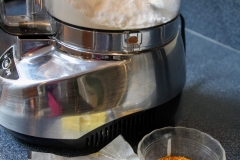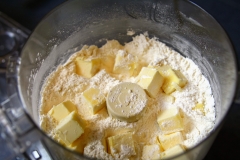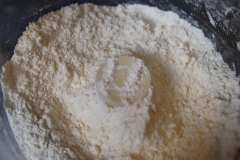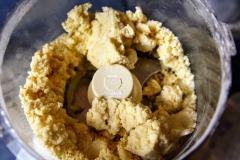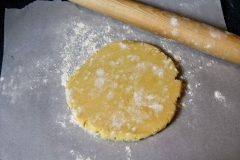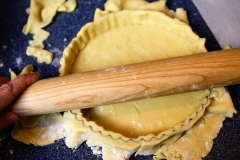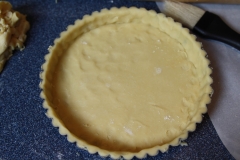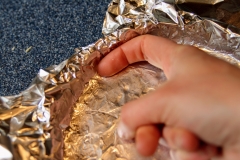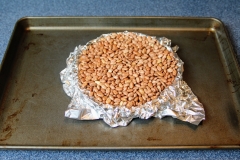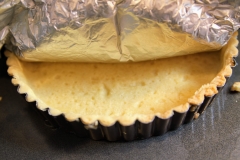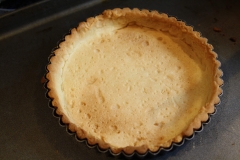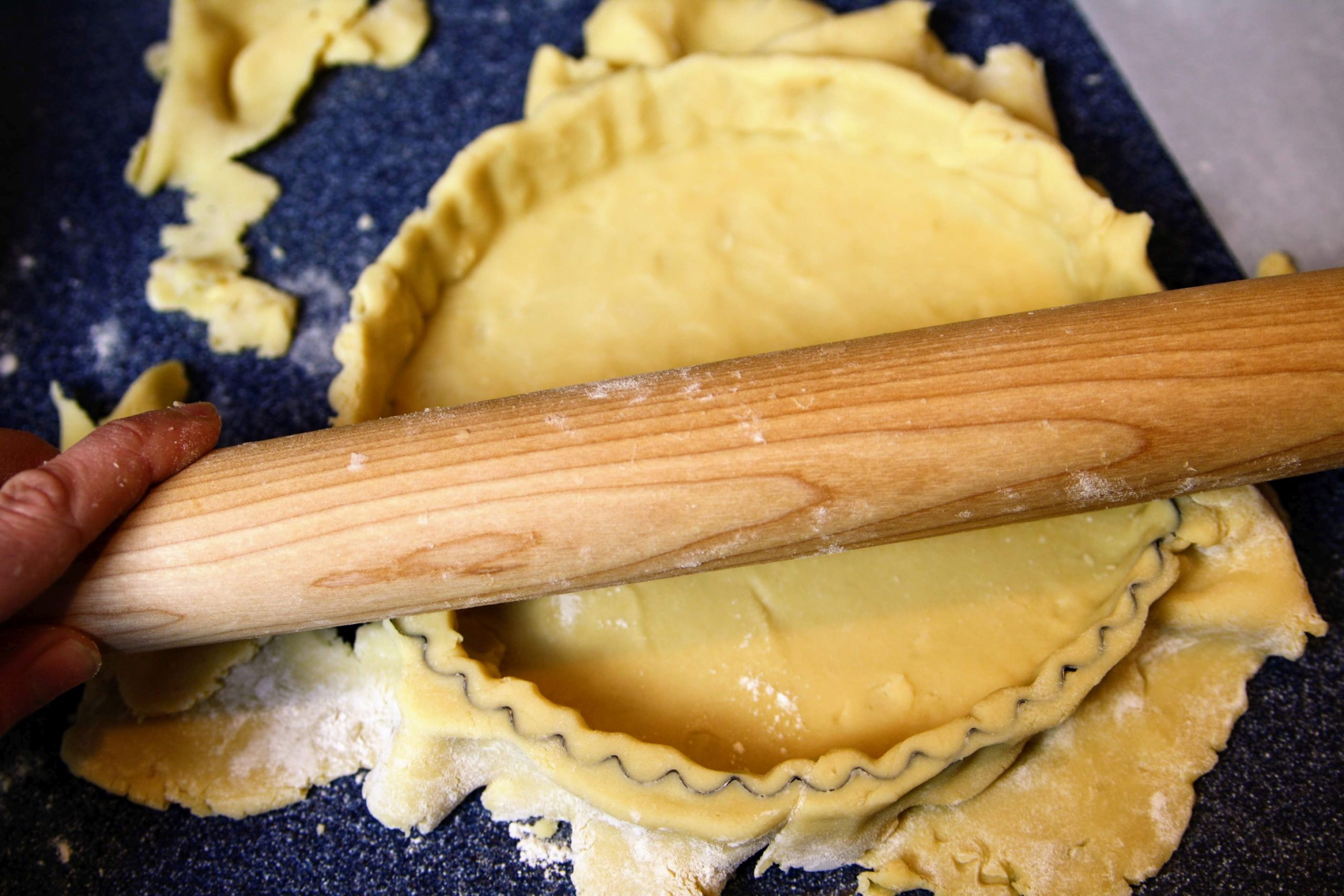
Sweet Tart Dough

This dough is the base for sweet tarts. My favorite ones usually involve fresh fruit but they are also delicious filled with fruit curds or chocolate. If you have scraps left over, they also make tasty cookies! Tart pans can be found in 9-inch, 6-inch, or individual sized pans. For this style of tart, only use pans with a removable bottom. The 9-inch pan is great if you’re serving a lot of people but it is a little overkill for a small dinner party. If we’re serving four people, I like using the 6-inch pan. The presentation is still beautiful and you’re left with only one or two slices afterwards. The individual pans are just fun and people always love eating personal-sized desserts.
Once the tart pans are lined, they’ll need to be blind-baked. All this means is that you’ll bake the tart filled with something (beans, in my case). The weight inside the pan keeps the sides intact while baking, so that the dough doesn’t droop or slide down when it gets warm. I’ve tried a variety of different pie weights and nothing has worked better for me than dried beans.
Sweet Tart Dough
Yield: enough for one 9-inch tart shell
1 yolk
1 Tb heavy cream
½ tsp vanilla
1 ¼ cups AP Flour
2/3 cup powdered sugar
¼ tsp salt
8 Tb unsalted butter, cubed, cold
In a small bowl, whisk together the yolk, cream, and vanilla. Set aside. In the bowl of a food processor, pulse together the flour, powdered sugar, and salt. Scatter the cubed butter over the top of the flour and process for several seconds at a time, until it resembles coarse cornmeal. With the machine running, add the yolk and cream mixture. Continue processing until the dough just comes together. Turn the dough out onto a clean surface and shape it into a round. Wrap in plastic and chill for at least 20 minutes.
Dust a piece of parchment paper with flour. Place your dough in the middle of your parchment and lightly dust with flour. Roll the dough out into a rough circle about 11-inches across. If it is too cold to roll out, let it sit on the counter for a few minutes, or give it a few solid whacks with your rolling pin (no, I’m not joking). The dough will handle much better if you keep it as cold as possible. If the dough gets too warm, it will become sticky and tear easily. If this happens, return the dough to the fridge and try again after it has chilled. The goal is to keep the dough in that sweet spot of warm enough to be able to work but cold enough that it’s still cooperative
At this point, if your dough feels as though it has started to warm up, place the whole piece of parchment (with your dough on top) in the freezer until it has chilled, probably between 5-15 minutes. If the dough still feels cold, you can go ahead and use it to line your tart shell. If you are using smaller tart shells and need to cut out pieces of the tart dough to line your molds, cut them about an extra inch larger than the diameter of the pan. Otherwise, leave your dough intact. Dust off any excess flour that may remain on the surface of the dough. Gently roll the dough around your rolling pin. You do this by placing your pin on one end of the rolled out dough. Pick up an edge and curve it around the pin. Begin rolling your pin over the rest of the dough, pulling the dough around the pin as you do so. Gently unroll the dough onto the tart pan. Carefully pick up pieces of the overhanging dough and use gravity to drape it down so that the dough fills in a 90° angle from the side of the pan to the bottom. If the dough slopes from the side to the bottom, your tarts will also have a sloped edge when unmolded. Gently press the dough into the sides of the pan, making sure it is secure and not slopping as it reaches the bottom. Roll your rolling pin over the top of the tart shell to remove any extra dough still attached. Using the scrap pieces, reinforce any thin areas. Make sure the dough is coming all the way to the top of the mold. Place the tart pan on a baking sheet and freeze until the dough is firm, 20-30 minutes.
Preheat the oven to 375°. Line the inside of the tart shell with heavy duty aluminum foil (if you don’t have heavy duty, use two layers of regular foil). Make sure that you’re pressing the foil all the way down into the edges. Fill with baking beans (see note above).
Bake for 15 minutes, rotate your pan 180°, and bake for 15 more minutes. Bake until the crust has some nice color and the bottom is set. You can check this by carefully lifting up the foil to peek at the crust below. If it still looks wet, then it needs more time. Continue checking every 3-5 minutes until it is set. Carefully remove the foil and the beans and stick them somewhere out of the way where they can cool down. Depending on what you’re using the shell for, you’ll either want a fully baked shell or a partially baked shell. Your recipe will indicate which one. If you just need a partially baked shell, then it’s done! If you’re using a fully baked shell, return it to the oven for 5-10 minutes until it is fully baked and the bottom has some nice color to it. During the whole baking time, you’ll want to keep a close eye on how dark your edges are getting. If you need to, cover the edges with foil to prevent them from getting too dark.
Allow a fully baked shell time to cool completely before using.
